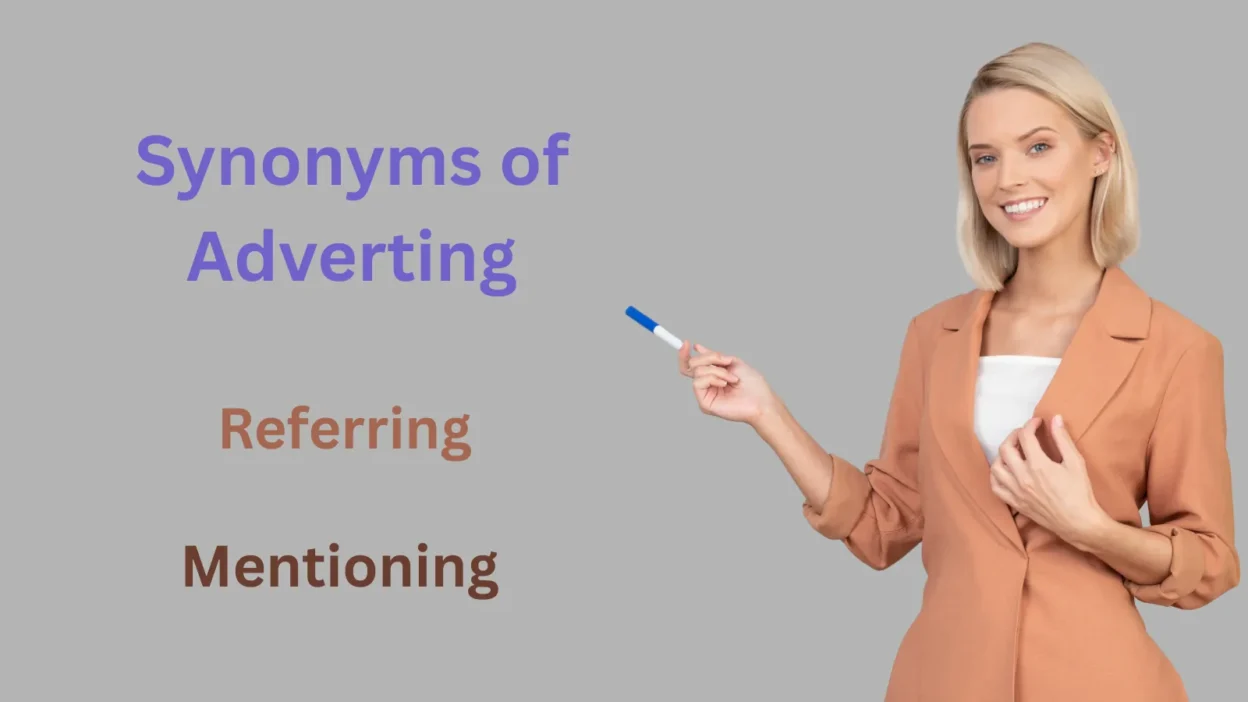Synonyms of adverting, such as referring, mentioning, and alluding, describe the act of drawing attention to something or bringing it up in conversation or writing. For example, a speaker might advert to an earlier topic to make a point or provide context.
Using the right synonym for adverting helps you express different shades of reference — from direct mentions to subtle hints. Each alternative highlights a distinct way of guiding your reader or listener toward an idea.
If you’re writing essays, articles, or formal communication, choosing othe words for adverting adds clarity and sophistication. In this guide, we’ll explore the best alternatives, their meanings, and how to use them effectively.
What Does Adverting Mean?
Adverting means turning attention toward something or briefly mentioning it. The word comes from the Latin advertere, which means “to turn toward.” It’s often used in formal writing or speech to show that someone is referring to a subject without going into full detail.
For example, a writer might advert to a previous argument or a speaker might advert to recent events to strengthen their point.
Depending on how it’s used, adverting can suggest:
- Direct reference or acknowledgment
- Subtle mention or hint
- A shift of focus toward a related topic
- Respectful or formal tone in writing
It’s not just about mentioning — adverting adds intention and direction to communication, helping ideas flow smoothly and logically.
30 Synonyms & Related Words for Adverting (And When to Use Them)
1. Referring
Description: Mentioning something directly or indirectly.
Example: “She kept referring to the incident throughout her speech.”
Usage: Most common and neutral synonym; fits academic and conversational contexts alike.
2. Mentioning
Description: Bringing something up in conversation or writing.
Example: “He avoided mentioning her name during the meeting.”
Usage: Neutral and everyday; softer and more direct than adverting.
3. Citing
Description: Quoting or referencing a source or authority.
Example: “The researcher cited three studies to support her claim.”
Usage: Ideal for academic, research, or formal writing.
4. Alluding
Description: Referring indirectly or subtly to something.
Example: “The author alluded to past tragedies through symbolism.”
Usage: Suited for literature or subtle references; slightly poetic.
5. Noting
Description: Drawing attention to or observing something noteworthy.
Example: “She began by noting the company’s progress.”
Usage: Professional and formal; often used in speeches and reports.
6. Pointing out
Description: Highlighting or emphasizing a detail or issue.
Example: “He kept pointing out flaws in the proposal.”
Usage: Common, conversational, and slightly assertive.
7. Drawing attention to
Description: Making others notice or focus on something.
Example: “The journalist drew attention to the government’s failures.”
Usage: Best for persuasive or informative writing.
8. Observing
Description: Commenting thoughtfully on something seen or noticed.
Example: “She observed that the trend was declining.”
Usage: Formal and reflective; suitable for essays and reports.
9. Bringing up
Description: Introducing a topic into a conversation.
Example: “I didn’t mean to bring up old memories.”
Usage: Informal and conversational; works well in dialogue.
10. Touching upon
Description: Discussing something briefly or lightly.
Example: “The lecture touched upon key points of the theory.”
Usage: Formal yet soft; used for surface-level discussion.
11. Commenting on
Description: Giving an opinion or remark about something.
Example: “She refrained from commenting on the issue.”
Usage: Neutral to formal; fits news or analytical writing.
12. Noticing
Description: Becoming aware of or acknowledging something.
Example: “He noticed her hesitation but said nothing.”
Usage: Neutral, observational, and slightly emotional.
13. Addressing
Description: Dealing with or talking directly about an issue.
Example: “The manager is addressing the customer complaints.”
Usage: Formal and proactive; implies responsibility.
14. Discussing
Description: Talking or writing about something in detail.
Example: “They were discussing the plan for hours.”
Usage: Neutral, clear, and suitable for both casual and professional tone.
15. Speaking of
Description: Transitioning to a related topic.
Example: “Speaking of vacations, have you booked your trip?”
Usage: Informal; perfect for conversational writing or dialogue.
16. Hinting at
Description: Suggesting something without stating it directly.
Example: “She kept hinting at a surprise announcement.”
Usage: Indirect and subtle; fits emotional or suspenseful contexts.
17. Indicating
Description: Pointing out or signaling something.
Example: “The data indicates a rise in unemployment.”
Usage: Factual, analytical; ideal for formal or scientific tone.
18. Emphasizing
Description: Giving special importance to something.
Example: “He emphasized the need for teamwork.”
Usage: Stronger than adverting; persuasive or motivational contexts.
19. Highlighting
Description: Making something stand out or noticeable.
Example: “The report highlighted major security concerns.”
Usage: Professional and modern; fits journalism and education.
20. Bringing attention to
Description: Intentionally making people notice something.
Example: “The documentary brought attention to climate injustice.”
Usage: Formal and ethical tone; often used in advocacy or awareness writing.
21. Cautioning about
Description: Warning or drawing attention to a risk.
Example: “Experts cautioned about the long-term effects.”
Usage: Serious, preventive tone; ideal for academic or journalistic writing.
22. Recalling
Description: Mentioning something remembered.
Example: “He recalled the time when the city was peaceful.”
Usage: Reflective or nostalgic tone.
23. Reporting
Description: Stating facts or events formally.
Example: “The agency reported a decline in trade.”
Usage: Objective and factual; used in news or official contexts.
24. Relating
Description: Telling or describing an event or story.
Example: “She related her experiences from the trip.”
Usage: Narrative tone; ideal for storytelling or first-person accounts.
25. Recounting
Description: Giving a detailed account of an event.
Example: “The witness recounted what happened that night.”
Usage: Formal or literary; focuses on storytelling precision.
26. Signaling
Description: Indicating indirectly through signs or gestures.
Example: “His tone signaled frustration.”
Usage: Modern, figurative, or physical indication; fits analytical or literary writing.
27. Naming
Description: Explicitly identifying or listing something.
Example: “The teacher named several key theorists in her lecture.”
Usage: Direct and specific; factual or academic tone.
28. Acknowledging
Description: Admitting or recognizing something’s existence.
Example: “He acknowledged the team’s hard work.”
Usage: Formal and respectful; used for recognition or admission.
29. Bringing into focus
Description: Concentrating attention on something important.
Example: “The essay brings into focus the role of empathy in leadership.”
Usage: Formal, reflective, and academic.
30. Making reference to
Description: Mentioning or citing something, often formally.
Example: “The writer made reference to earlier studies on the subject.”
Usage: Academic or formal; closest to adverting in tone and function.
How to Choose the Right Synonym
The right synonym for adverting depends on tone, intention, and audience:
- Academic and Professional: Use referring, citing, noting, addressing, or making reference to. These are precise, objective, and respectful.
- Literary or Creative: Opt for alluding, hinting at, touching upon, or recounting to maintain a subtle or emotional tone.
- Casual or Conversational: Choose bringing up, speaking of, or pointing out for informal communication.
- Analytical or Critical: Highlighting, indicating, and emphasizing convey focus and clarity.
- Reflective or Personal: Recalling, relating, or acknowledging feel natural in memoirs or emotional writing.
Cultural and Emotional Nuance
In formal or traditional contexts (like legal or academic writing), adverting and its close synonyms (making reference to, referring to) still appear because they suggest professional detachment and precision. In contrast, modern communication prefers clarity and simplicity, favoring mentioning or pointing out.
Conclusion
Exploring synonyms of adverting helps you express attention, reference, and connection with precision. Words like referring, mentioning, and alluding let you guide your audience naturally from one idea to another. Each synonym adds its own tone — from formal to conversational — allowing you to adapt your writing to any context.
Using the right synonym not only improves clarity but also keeps your communication smooth and engaging. Whether you’re writing essays, reports, or discussions, these alternatives to adverting make your language more thoughtful and precise.





